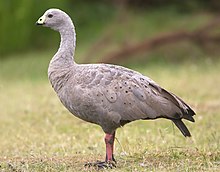Lake Newland Conservation Park
| Lake Newland Conservation Park South Australia | |
|---|---|
| Nearest town or city | Elliston |
| Coordinates | 33°24′18″S134°51′16″E/ 33.40500°S 134.85444°E[1] |
| Established | 1 August 1991[2] |
| Area | 88.8 km2(34.3 sq mi)[3] |
| Managing authorities | Department for Environment and Water |
| Website | Lake Newland Conservation Park |
| See also | Protected areas of South Australia |
Lake Newland Conservation Parkis aprotected areain the Australian state ofSouth Australialocated on the west coast of theEyre Peninsulaabout 10 kilometres (6.2 mi) north of the town ofElliston.It was proclaimed in 1991 in order to protectLake Newland,a hypersaline lake, and an associatedwetlandcomplex. It lies in the traditional lands of theWirangu people.
History and description
[edit]The conservation park is located within the gazetted localities (from south to north) of Elliston,Colton,andTalia.[4]It stretches 20 kilometres (12 mi) along a coastal strip, and includes the largesand duneswhich lie between the lake and the sea.[5]
Land within the conservation park has a relatively recent geological history, withHolocenesand dunes creating a barrier between theSouthern Oceanand a depression in the Bridgewater Formation ofPleistocenelimestone that is common throughout the western Eyre Peninsula.[6]
Thetraditional ownersof the land, anAboriginalpeople of the west coast of South Australia known as theWirangu,were forced off their land in the 1800s as European settlers moved into the area and started farming the area inland of the lake, blocking their access to the lake, dunes and sea. After theElliston massacrein May 1849 at Waterloo Bay, the whole area becametabooto Aboriginal people, and they did not set foot in it until 2018, when acleansing ceremonywas performed.[5][7]
Lake Newland was named byEdward John Eyrefor his friend and travelling companionRichard Francis Newland,during hisEyre's 1839 expeditions to the west.[4][8]
The conservation park was proclaimed in 1991 (named after the lake[4]), with some additional land being added in 1996.[6]
It is classified as anIUCNCategory Ia protected area.[1]The dunes continue to encroach on the lake, lagoons and other wetlands in the park, which are also fed byfreshwater springsin thelimestone.Average annual rainfall (recorded at Elliston) is 427 millimetres (16.8 in).[6]
Vegetation
[edit]The conservation park contains mobile sand dunes and sub-coastal wetlands. The vegetation includes areas of previously cleared land with patches of regeneratingdrooping sheoakwoodlandand scattered native shrubs. The lake margins are dominated by salt-tolerantSarcocorniaandTecticorniaspecies. The coastal shrublands that cover much of the reserve are mainly composed ofcoastal daisybush,withcoast beard-heath,seaberry saltbush,long-pod wattle,coastal umbrella bushandcockies tongues.The foredunes behind the beach containSpinifex hirsutusgrassland as well ascoast saltbushandknobby club-rush.Swalesare characterised byswamp paperbarksanddryland tea-treesover salt-tolerant shrubs.[6]
Other designations
[edit]
The full extent of the conservation park is overlapped by anImportant Bird Area(IBA) known as the Lake Newland Important Bird Area. The IBA which is a non-statutory arrangement has been identified byBirdLife Internationalbecause it regularly supports over 1% of the world population ofCape Barren geese,as dry-season visitors from their offshore island breeding grounds, and significant numbers offairy ternsandhooded plovers.[9]Slender-billed thornbillsalso occur in the park.[6]
In Aboriginal mythology
[edit]Lake Newland is steeped inAboriginal Australian mythology,specifically that of the Wirangu people. It is connected to thestory of the Seven Sisters(based on the star constellation known as thePleiades), acreation storyembodied in asonglineof great significance. In the story, a hunter named Tgilby (theOrion constellation), after falling in love with the seven sisters (Pleiades), known as Yugarilya, chases them out of the sky and onto and across the earth. He chases them as the Yugarilya chase a snake, Dyunu.[5]
References
[edit]- ^abc"Terrestrial Protected Areas of South Australia (refer 'DETAIL' tab )".CAPAD 2016.Australian Government, Department of the Environment (DoE). 2016.Retrieved21 February2018.
- ^Rann, M.D. (1 August 1991)."NATIONAL PARKS AND WILDLIFE ACT 1972 SECTIONS 30 AND 43: CONSTITUTION OF, AND MINING IN, CONSERVATION PARK"(PDF).The South Australian Government Gazette.Government of South Australia. p. 490.Retrieved2 July2019.
- ^"Protected Areas Information System - reserve list (as of 25 November 2014)"(PDF).Department of Environment Water and Natural Resources.Retrieved8 January2015.
- ^abc"Search result for" Lake Newland Conservation Park "(Record no. SA0038338) with the following layers selected -" Suburbs and Localities "and" Place names (gazetteer) "".Property Location Browser.Government of South Australia. Archived fromthe originalon 12 October 2016.Retrieved16 November2016.
- ^abcHamilton, Jodie (7 October 2020)."Seven Sisters stars creation story reconnecting people to their country after clifftop massacre taboo lifted".ABC News.Australian Broadcasting Corporation.Retrieved11 November2020.
- ^abcdeDurant, M.D. (2009).Lake Newland Conservation Park: Opportunities for Implementation of the WildEyre Conservation Action Plan(PDF).Report to the WildEyre project group. Greening Australia SA.
- ^Jonscher, Samantha (14 October 2018)."Waterloo Bay monument to historic massacre allows community to reflect on reconciliation since opening".ABC News.Australian Broadcasting Corporation.Retrieved12 November2020.
- ^"Journal of Expeditions in Central and Southern Australia".The South Australian.Vol. IX, no. 708. South Australia. 24 February 1846. p. 3.Retrieved15 November2016– via National Library of Australia.
- ^"IBA: Lake Newland".Birdata.Birds Australia. Archived fromthe originalon 6 July 2011.Retrieved29 July2011.

